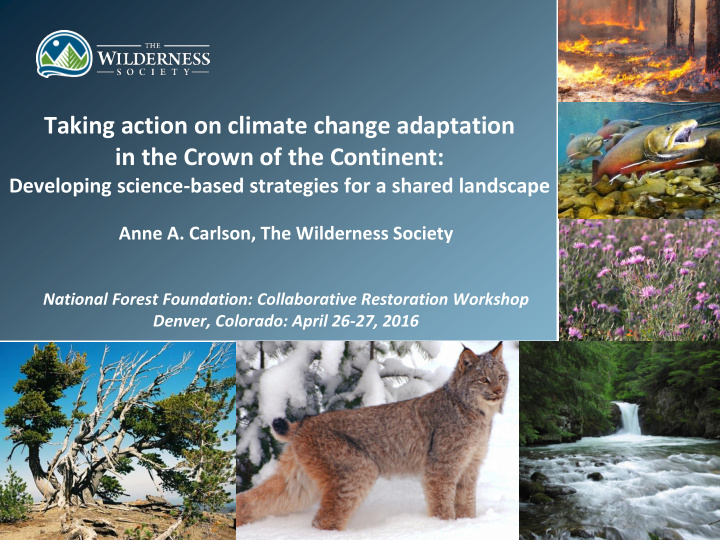



Taking action on climate change adaptation in the Crown of the Continent: Developing science-based strategies for a shared landscape Anne A. Carlson, The Wilderness Society National Forest Foundation: Collaborative Restoration Workshop Denver, Colorado: April 26-27, 2016
The Crown of the Continent • 18 million acre landscape: NW Montana, SE British Columbia and SE Alberta • No known extinctions since Lewis and Clark first traveled through 200 years ago • Home to the Continent’s water tower • Important habitat for grizzly bear, elk, deer, lynx, gray wolf, wolverine, Canada lynx, a wide variety of bird species and native salmonids • Restoration/management needs: noxious weeds and invasive fish species, old logging roads, mining activities, decades of fire suppression, and climate change
Existing Crown collaboratives and initiatives • Crown Managers Partnership • Crown Conservation Initiative ----------------------------------------------------------------------------------------------------------------------- • Southwestern Crown of the Continent Collaborative Forest Landscape Restoration Program (CFLRP) project • Confederated Salish and Kootenai Tribes; Blackfoot Confederacy ---------------------------------------------------------------------------------------------------------------------- • Northern Rockies Adaptation Partnership (Region 1 of the US Forest Service) • Great Northern Landscape Conservation Cooperative (GNLCC) ----------------------------------------------------------------------------------------------------------------- • Lolo, Lincoln, and Seeley Lake Restoration Committees • The Blackfoot Challenge; Cows and Fish ------------------------------------------------------------------------------------------------------------------ • America’s Great Outdoors (AGO) Map courtesy of Crown Managers Partnership
Existing Crown collaboratives and initiatives • Crown Managers Partnership • Crown Conservation Initiative ----------------------------------------------------------------------------------------------------------------------- • Southwestern Crown of the Continent Collaborative Forest Landscape Restoration Program (CFLRP) project • Confederated Salish and Kootenai Tribes; Blackfoot Confederacy ---------------------------------------------------------------------------------------------------------------------- • Northern Rockies Adaptation Partnership (Region 1 of the US Forest Service) • Great Northern Landscape Conservation Cooperative (GNLCC) ----------------------------------------------------------------------------------------------------------------- • Lolo, Lincoln, and Seeley Lake Restoration Committees • The Blackfoot Challenge; Cows and Fish ------------------------------------------------------------------------------------------------------------------ • America’s Great Outdoors (AGO) • The Wilderness Society Map courtesy of Crown Managers Partnership
Identifying shared priorities at the landscape-scale Our first ‘Big Tent’ workshop Addressing climate change collaboratively through Climate Adaptation Partnership (CAP) • Use of the best available science • Landscape scale • Diverse and inclusive collaboration • A solid understanding of the priorities and directives of each jurisdiction in the Crown • Shares effective management actions across jurisdictions • Establishes adaptive management frameworks • Engages a mixture of senior-level/ middle managers, and on-the-ground biologists
Bull trout and westslope cutthroat trout Our second ‘Big Tent’ workshop • Climate ( increasing stream temps ) and non-climate ( hybridization, habitat fragmentation ) threats • US Forest Service ( NRAP) : shared vulnerability assessments + climate adaptation strategies • Ground-breaking climate science by Clint Muhlfeld and Leslie Jones ( US Geological Survey ) at landscape-scale • Provided basis for cross-jurisdictional/ transboundary discussions + dev’t of coarse- and fine-scale strategies • Workshop outcomes: re-founding WSCT on East side of Divide; transloca- tion of bull trout to potential climate refugia; ID conservation priority popns
Battling terrestrial invasive plants together Our third ‘Big Tent’ workshop • Pre-workshop survey to identify top 10 priority species • Bray Beltran ( Heart of the Rockies ) modeled suitable habitat under current (1981- 2010) and future (2050) climate scenarios using two Representation Concentration Pathways (4.5 and 8.5) • Suitable habitat for 7/10 species projected to expand across Crown by 2050 & across jurisdictional boundaries • Coordinated work: Crown- wide inventory and monitor- ing; maintain weed free areas; borderless management
Restoring five-needle pine forests Our fourth ‘Big Tent’ workshop • Whitebark pine (WBP) and limber pine forests in significant decline: keystone species, important to tribes in region • WBP is a candidate species under ESA + listed as endangered under Canada’s Species at Risk Act (SARA) • Threats: blister rust; mountain pine beetle outbreaks; impacts of fire exclusion; climate change • Best available science: status; trends; restoration strategies & effectiveness • GYCC presentation on WBP restoration • Developing a Crown-wide restoration strategy; initiating multi-jurisdictional monitoring; learning networks for restoration strategies and use of fire
What’ Next? Meso-carnivores and prescribed fire • Canada lynx, wolverines • Phased approach to meso- carnivore CAP work: collaborat- ed with NFF in co-organizing a meso-carnivore monitoring workshop in Dec. 2015 • What do we know about current distributions, status, and jurisdictional priorities for these species regionally? • Planning for CAP meso- carnivore workshop beginning in earnest in 2016 • Planning for CAP workshop on prescribed fire in mixed severity fire regimes in 2017
The U.S. Forest Service: Leaders - and beneficiaries - of this approach • U.S. Forest Service manages 5.5 million acres of 18 million acre Crown landscape • U.S. Forest Service has been critically important in dev’t of this approach • Region 1 vision & leadership: Linh Hoang (RO), Chip Weber (Flathead NF), Rob Davies (Hungry Horse District Ranger), Scott Spaulding (RO) • FS better poised to successfully address requirements of different mandates, directives, policies (e.g. 2012 Forest Planning Rule; updat- ed monitoring program in 2016; published science; NEPA) • It’s collaborative!! • Potential for joint fundraising • Recognition of CAP’s work: Obama Admini- stration’s Resilient Lands & Waters Initiative
Anne Carlson, The Wilderness Society (Anne_Carlson@tws.org) Linh Hoang, U.S. Forest Service (Region 1; Northern Rockies Adaptation Partnership) Erin Sexton, Institute on Ecosystems at the University of Montana Regan Nelson, Crown Conservation Initiative Ian Dyson, Alberta Environment and Parks Thank you!! Questions? Thank you! Questions?
Recommend
More recommend